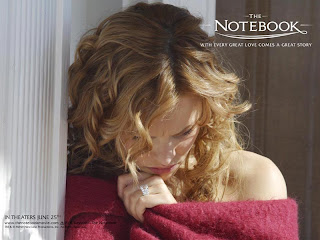The Notebook
After discussing various camera shots during class today, I wanted to find a movie in which these shots were apparent so I could blog about it. I began looking through my collection of movies and "The Notebook" stuck out to me. Throughout the movie I came across many of these shots, all which were more obvious to me after learning about them, and all affecting the way I viewed the movie. There were many times throughout the movie when a love scene would come on and the camera shots would become closer, this showing the intimacy between Noah and Allie, the two main characters. One shot that really stuck out to me was toward the end of the movie. I would consider this shot to be close-up. At this point in the movie the drama has really set in, and with this shot the audience is drawn into the situation and it's suspense.
Now this picture is not the exact shot shown at the beginning of the film, however it looks somewhat like it, and this is not the exact place Allie and Noah visited. But, I just found it different that the audience was not immediately introduced to the main setting of the film right off the bat. Obviously, the setting changes frequently throughout the film, (as it does in many films, due to the length and plot) so it would be hard to stay consistent. But, because this was different from what is usually shown, to me, it was a little more appealing and not necessarily distracting- however, this may depend on a viewer's preference. Plus, as I stated before it is harder to do so in a film of longer length and a more complex plot, unlike television shows like "Full House" or "Family Matters." By becoming aware of these different camera shots, I paid more attention to the plot and got more out of it by being drawn into the film. This in turn changed my way of watching the film, which in essence is exactly what directors and producers are shooting for.



